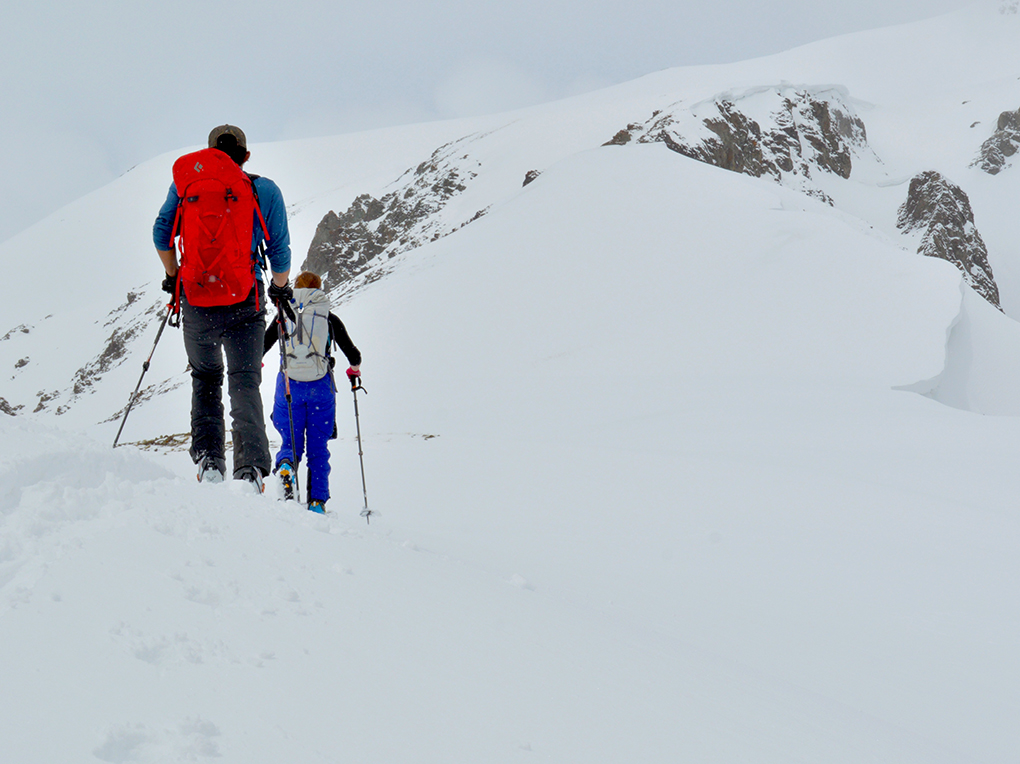Performance
I wore the OR Cirque pants in just about every mountain condition imaginable. From bluebird days on alpine granite around Mt. Whitney, to full whiteout conditions on Mt. Sneffels, to cooking in the solar oven of a snow-filled basin in the Sangre de Cristo mountains, to bushwhacking through willows and deadfall in the Sawatch range. The Cirque pants saw it all.
When skiing or snow-climbing, the pants did wet out a bit as you would expect from a softshell, but they also dried extremely quickly with no loss of function. I rarely felt the need to wear long underwear with the pants, even when the temperature dropped below freezing—the caveat, of course, being that staying warm in so few layers requires near-continuous movement.

On the flip side, I found the Cirque pants to get fairly hot. As light as the lining is, it provides enough insulation to make wearing the pants in the blazing sun uncomfortable. When slogging through snow or hiking on a trail on a sunny day, I was sweating a lot. The Cirque pants are an excellent fall, winter, and spring pant, but the lining makes them too heavy for much summer use.
Durability
The durability of the fabric used in the Cirque pants is on par with any other softshell I’ve tested. It is stretchy enough to stand up to repeated abrasion against rock, though I did manage to put a tiny hole in the knee from bracing my kneecap on the granite of Mt. Whitney.
In the last few days of wearing these pants while instructing a 22-day mountaineering course this summer, the pants did get a few holes, but I attribute those more to my momentary clumsiness and a co-instructor’s decision to store his pack with the ice axe pointed up, than to any inherent deficiency in the durability of the fabric.
The weather proofing did degrade more quickly than more waterproof softshells like the Patagonia Knifeblade, but that reflects on the intended purpose of the Cirque pants: they are not designed to be a stormproof shell, but rather a highly breathable softshell, and as such do not have a traditional full DWR coating. Instead, they rely on the weave of the fabric to provide weather resistance.
The only drastic durability issue I encountered was with the stitching. In the first few days of wear, I noticed some loose threads in the gusseted crotch, as well as on the cuffs, which only got worse over time. Although I am not in danger of accidentally exposing myself when wearing the pants, it is frustrating to see something as simple as stitching start to wear out so early.
Bottom Line
Outdoor Research positions these pants as a workhorse, ready for any condition. I put them through the gamut, and the Cirque pants performed through it all. Although they would not be my first choice for a summer backpacking pant, I would definitely grab the Cirque pants for any outdoor adventure that didn’t entail higher temperatures.
The Cirque pants are one of the best options available to anyone looking for a softshell pant that performs equally well skiing, ice climbing, or alpine rock climbing. The well-designed cuffs in particular make the Outdoor Research Cirque pants especially well-suited to any endeavor involving significant snow travel.

Thanks for the review. I’m looking forward to getting a pair of Cirque pants for this winter. For the warmer months check out the Ferrosi pant from OR. I’ve had a pair since this spring and have used them skiing and hiking from the 30’s up into the 70’s and have found them to be remarkably comfortable in that range (as long as you keep moving in the lower temperature ranges). Keep up the good work Blister!
hey, nice review, have you used them underneath rain pants? does it breath well?
Hi Joaquin,
I have worn the Cirque pants under a pair of rain pants. Ultimately breathability in that situation is dictated more by your choice of rain pants and not the softshells as any pair of rain pants is less breathable than softshells.
Often though I do not wear both hardshells and softshells at the same time though. Reason being that if I’m moving fast enough that I need the breathability of softshells I will sweat out in hardshells regardless of the temperature and get cold and wet. So I typically will wear just softshells when moving and then put on hardshells if I am stopped and breathability isn’t a concern.
Hope that answers your question.
matt